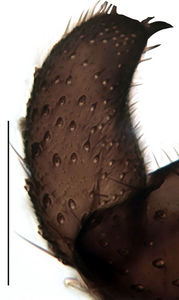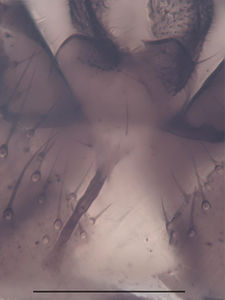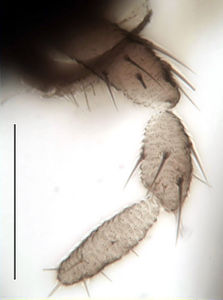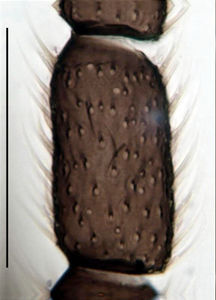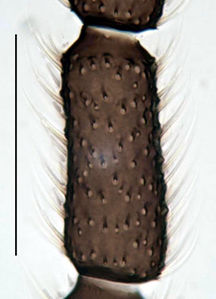Trichosiopsis juliae
| Notice: | This page is derived from the original publication listed below, whose author(s) should always be credited. Further contributors may edit and improve the content of this page and, consequently, need to be credited as well (see page history). Any assessment of factual correctness requires a careful review of the original article as well as of subsequent contributions.
If you are uncertain whether your planned contribution is correct or not, we suggest that you use the associated discussion page instead of editing the page directly. This page should be cited as follows (rationale):
Citation formats to copy and paste
BibTeX: @article{Heller2012VeröffentlichungendesMuseumsfürNaturkundeChemnitz35, RIS/ Endnote: TY - JOUR Wikipedia/ Citizendium: <ref name="Heller2012Veröffentlichungen des Museums für Naturkunde Chemnitz35">{{Citation |
Ordo: Diptera
Familia: Sciaridae
Genus: Trichosiopsis
Name
Trichosiopsis juliae (Heller, 2012) – Wikispecies link – ZooBank link
- Leptosciarella (Leptosciarella) juliae Heller, 2012[1]: 100-101, fig. 5
Type material
Holotype ♂, no 2438 in SDEI, Malaise trap, leg. Irwin, 03.-24.02.1999
Type locality
Spain, Zaragoza Prov., Sierra de Alcubierre, Los Monegros, Pina de Ebro
Paratypes
Spain, 1 ♂, same data as holotype, SDEI 2439.
Description (male)
Head. Eye bridge 3–4 rows of facets. Antenna unicolour. LW-index of 4th flagellomere 1.7–2.5; neck 0.2–0.35 × segment width; transition of basal part to neck pronounced. Colour of neck unicolour. Antennal setae shorter than segment width; of normal strength; dense; salient. Palpus darkened; of normal length; palpomeres 3. First palpomere of normal shape; with 6–10 setae; with only sparse sensilla. Second palpomere short and oval. Third palpomere as long as first. Thorax. Colour brown. Notum unicolour. Thoracic setae long and strong, or normal; black. Posterior pronotum setose. Postpronotal setae 1–3; strong. Mesothoracic sclerites bare. Legs. Colour yellow-brown. Hind coxa darkened. Setae on front coxa darkened, or pale. Front tibial organ as patch of setae; dark; front tibial organ not bordered. Tibial setae on hind legs normal, shorter than tibial width. Tibial spurs of equal length. Claws untoothed. Wing. Wing slightly darkened; of normal shape. Wing membrane without macrotrichia. Wing venation weak, with faint stM. M-fork of normal shape. R1 ending at or slightly before base of m-fork; posterior veins with macrotrichia; stM mostly with macrotrichia; CuA1 and CuA2 mostly with macrotrichia; bM bare; r-m mostly setose; bM:r-M 0.4–0.65; st-Cu:bM 0.4–0.8; R1:R 1.3–1.7; c:w 0.6–0.7. Halter darkened; of normal length. Abdomen. Abdominal setae strong; on tergites black; on sternites black. Hypopygium concolour with abdomen; LW-index 0.55–0.7. Base of gonocoxites with weak setae; gonocoxites broadly separated; inner margin of gonocoxites typically U-shaped; inner membrane of hypopygium bare; ventral margin of gonocoxite with short setae. Gonostylus elongate; LW-index 2.2–2.6; Inner margin straight, or concave; apex tapered, or equally rounded. Apical tooth present; without internal structure; strong, or of medium strength; LW-Index 2.05–2.5. Awl-like setae normal; present beneath apical tooth. Megasetae absent. Whiplash-hair absent. Tegmen 0.5–0.7 × longer than broad; rectangular with rounded edges; without special features; central process absent. Length of ejaculatory apodeme/hypopygium 30–40 %; base of ejaculatory apodeme present. Field with aedeagal teeth inconspicuous. Measurements. Body size 2.3–2.6 mm. Hind tibia 1.33–1.5 mm. Wing length 2.4–2.7 mm.
Diagnosis and discussion
Trichosiopsis juliae is a small, dark species without any special characters. By the completely dark abdominal hairs, the bright hairs at the fore coxae and the presence of an apical structure at the aedeagus it resembles Trichosiopsis zanti. But it can be distinguished by the strong bristles on the first palp segment, the dorsally more rounded gonostyles and less hairs on the posterior pronotum. By the less elongate gonostyles and the strong bristles on the first palp segment this species leads over to the species complex around Trichosiopsis viatica.
Etymology
The species was named after Kai Heller´s colleague, Julia Kutz.
Distribution
Spain[1].
Images
|



